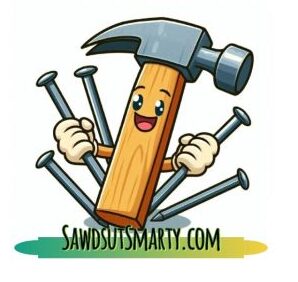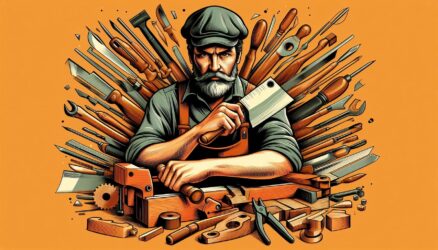In woodworking, sharp tools aren’t a luxury — they’re a necessity. Whether you’re planning a board, paring a mortise, or slicing a dovetail, dull blades make your work harder, more dangerous, and less precise. Sharpening and maintaining your tools not only protects your investment, but it also improves the quality, efficiency, and safety of every project you take on.
This comprehensive guide covers everything you need to know to sharpen, maintain, and care for the most common woodworking tools, from chisels and hand planes to saw blades and router bits.
As an Amazon Associate, I earn from qualifying purchases.
🛠️ Why Tool Maintenance Matters
Maintaining sharp, clean, and properly adjusted tools leads to:
- Cleaner cuts with less tear-out
- Less effort in cutting or shaping wood
- Increased safety due to less forcing and slipping
- Longer tool lifespan
- Higher precision and control
In short: a sharp tool is a safe and productive tool. Let’s break it down by category.
🔪 Sharpening Chisels
Chisels are one of the most used — and abused — tools in the shop. A properly sharpened chisel can slice through wood fibers like a knife through butter.
When to Sharpen:
- You feel resistance where there shouldn’t be.
- The edge glints in the light (a dull edge reflects light).
- You’re getting tear-out instead of smooth shavings.
What You’ll Need:
- Bench grinder or coarse sharpening stone (for damaged tools)
- Waterstones or diamond stones (1000, 3000, 8000 grit recommended)
- Honing guide (optional but helpful for beginners)
- Strop with polishing compound (for final polish)
How to Sharpen a Chisel:
- Flatten the back of the chisel using your coarsest stone.
- Use a honing guide to hold the bevel at a consistent angle (usually 25–30°).
- Start with a coarse stone and move through finer grits, ending with 8000.
- Strop the edge on leather with polishing compound.
- Test the edge — if it shaves hair or slices paper cleanly, it’s ready.
💡 Tip: Don’t forget to remove the burr on the back before testing or using.
🪵 Sharpening and Tuning Hand Planes
A sharp plane blade makes flattening and smoothing wood feel like magic. But a dull iron can chatter, tear out, or stop cutting altogether.
Step-by-Step:
- Remove the iron from the plane and disassemble the chip breaker.
- Sharpen the iron the same way you would a chisel — consistent bevel angle, polished back, clean stropping.
- Check the sole of the plane for flatness with a straight edge. Flatten on sandpaper stuck to a flat surface if needed.
- Reassemble and set the blade depth. Test on scrap wood and adjust the lateral alignment and depth until you get fine, curly shavings.
🪚 Sharpening Hand Saws
Most new woodworkers skip saw sharpening and buy replacements — but sharpening your own saws gives you control over cut quality and saves money long-term.
Tools Needed:
- Saw file (size depends on tooth size)
- Saw vise or clamp
- Triangular file and possibly a saw set
- Ruler and magnifier
How To:
- Secure the saw in a vise with teeth facing up.
- File each tooth at the correct angle (rip teeth are 90°, crosscut are typically 75°).
- Use even strokes and file every other tooth first, then switch sides.
- Use a saw set to slightly bend each tooth outward (alternating sides) to create the kerf.
- Test on scrap wood and adjust if the saw veers or binds.
💡 Pro Tip: Practice on an old saw first — it takes finesse.
** Here’s a little transparency: Our website contains affiliate links. This means if you click and make a purchase, we may receive a small commission. Don’t worry, there’s no extra cost to you. It’s a simple way you can support our mission to bring you quality content.**
🌀 Maintaining Router Bits
Router bits get a lot of use and dull quickly when cutting hardwood, plywood, or MDF. Dull bits can scorch wood, chatter, or even break.
Maintenance Tips:
- Clean with resin remover or bit cleaner to remove pitch and gunk.
- Use a diamond hone to sharpen the flat edges. Do NOT alter the profile.
- Avoid over-sharpening. A couple of light strokes is often enough.
- Store router bits in protective cases or foam-lined drawers.
Replace bits with nicks, burns, or wobble — they’re not worth salvaging if safety is compromised.
⚙️ Sharpening Power Tool Blades
Circular Saw and Miter Saw Blades:
These can be resharpened by professionals, or replaced once dull. Look for:
- Chipped or missing teeth
- Burn marks on wood
- Increased effort to cut
- Loud whining or smoking
If you use high-end blades, having them professionally resharpened (around $10–$15) is cost-effective. For budget blades, replacement may be more practical.
🪓 Honing Axes and Drawknives
For traditional or rustic woodworking, keeping your axe, adze, or drawknife sharp is key.
Tools:
Steps:
- File to shape, following the factory bevel.
- Use a stone to refine the edge.
- Strop for a polished finish.
- Check sharpness by shaving bark or slicing through paper.
🧼 General Maintenance for All Tools
Proper sharpening is important, but ongoing maintenance is what keeps your tools in top shape for the long haul.
Rust Prevention:
- Keep tools dry and store them off concrete.
- Wipe metal surfaces with a rag and apply a light coat of oil or paste wax.
- Use silica gel packets or a dehumidifier in your tool storage.
Wooden Handles:
- Inspect for cracks or looseness.
- Apply linseed oil to prevent drying or splitting.
Tool Storage Tips:
- Hang tools on walls using French cleats or pegboards.
- Store in protective cases or tool rolls to avoid dulling and chipping.
- Label drawers or bins for faster access.
🧠 Skill-Building: Make Sharpening a Habit
For beginners, sharpening can seem intimidating — but it’s a foundational skill. Here’s how to build confidence:
- Start with one tool (a chisel is ideal).
- Watch tutorials or join a local woodworking class.
- Keep a sharpening log with dates and notes.
- Invest in quality stones or systems gradually.
Once sharpening becomes part of your routine, you’ll find less frustration and more joy in every project.
🧱 Final Thoughts
Sharpening and maintaining your woodworking tools may not feel as exciting as cutting joinery or assembling a project — but it’s the foundation of quality craftsmanship.
A sharp chisel or blade turns rough work into fine joinery. A clean plane makes wood surfaces buttery smooth. And maintaining your tools preserves your investment for decades to come.
So, set aside some time each month to care for your tools. Your hands — and your woodworking — will thank you.
📸 Show Us Your Sharpening Setup!
Got a sharpening station or tool maintenance tip to share? Tag @SawdustSmarty or use the hashtag #SmartSawdust for a chance to be featured in our monthly roundup!


